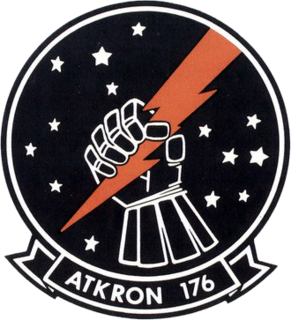
Attack Squadron 176 (VA-176), known as the "Thunderbolts", was a United States Navy carrier-based medium attack squadron that saw combat service in the Vietnam War and later in 1983 in both Grenada and Lebanon.
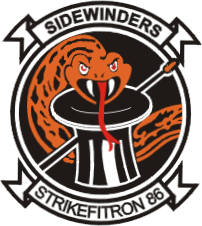
Strike Fighter Squadron 86 (VFA-86) is a strike fighter squadron of the United States Navy based at Naval Air Station Lemoore, California. The squadron is nicknamed Sidewinders, leading to the call sign Winder. The unit currently flies the F/A-18E Super Hornet and is assigned to Carrier Air Wing Seven, tail code AG.

A carrier air wing is an operational naval aviation organization composed of several aircraft squadrons and detachments of various types of fixed-wing and rotary-wing aircraft. Organized, equipped and trained to conduct modern US Navy carrier air operations while embarked aboard aircraft carriers, the various squadrons in an air wing have different but complementary missions, and provide most of the striking power and electronic warfare capabilities of a carrier battle group (CVBG). While the CVBG term is still used by other nations, the CVBG in US parlance is now known as a carrier strike group (CSG).

Carrier Air Wing Nine (CVW-9) is a United States Navy aircraft carrier air wing based at Naval Air Station Lemoore. The Air Wing is currently assigned to the aircraft carrier USS Abraham Lincoln (CVN-72). The Tail Code of aircraft assigned to CVW-9 is NG.

Strike Fighter Squadron 2 (VFA-2) also known as the "Bounty Hunters" is a United States Navy F/A-18F Super Hornet strike fighter squadron based at Naval Air Station Lemoore, California. Their tail code is NE and their callsign is "Bullet". They are attached to Carrier Air Wing 2 (CVW-2), a composite unit made up of a wide array of aircraft performing a variety of combat and support missions that deploy aboard the Carl Vinson.
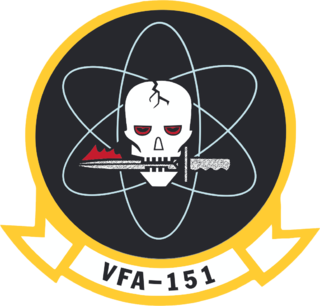
Strike Fighter Squadron One Five One (VFA-151) nicknamed the Vigilantes are a United States Navy F/A-18E Super Hornet fighter squadron stationed at Naval Air Station Lemoore, California. The squadron is a part of Carrier Air Wing 9 (CVW-9). As part of CVW-9, the squadron's tail code is NG and its radio callsign is "Ugly".

Strike Fighter Squadron 195 (VFA-195), also known as the "Dambusters", is a United States Navy F/A-18E Super Hornet fighter squadron stationed at Marine Corps Air Station Iwakuni, Japan. They are a part of Carrier Air Wing Five (CVW-5) and their tail code is NF. Their radio callsign is "Chippy".

Strike Fighter Squadron 105 (VFA-105) also known as the "Gunslingers" is a United States Navy strike fighter squadron based at Naval Air Station Oceana, Virginia. The "Gunslingers" are an operational fleet squadron and fly the F/A-18E Super Hornet. Their radio callsign is "Canyon" and the tail code is AC.

Airborne Command and Control Squadron 123 (VAW-123) is based at Naval Station Norfolk, flying the E-2C Hawkeye. They are attached to Carrier Air Wing Three (CVW-3) while deployed aboard USS Dwight D. Eisenhower. The squadron nickname is the Screwtops.
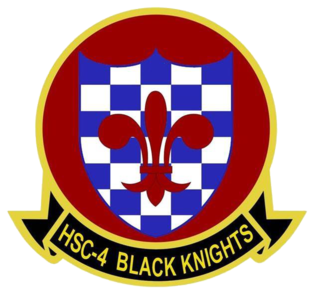
Helicopter Sea Combat Squadron Four (HSC-4), also known as the Black Knights, is a multi-role combat helicopter squadron of the United States Navy based at Naval Air Station North Island which operates Sikorsky MH-60S Seahawk helicopters deployed aboard aircraft carriers. The squadron was originally established as HS-4 on 30 June 1952 at U.S. Naval Auxiliary Landing Field Imperial Beach with the Sikorsky HO3S-1 and was redesignated HSC-4 on March 29, 2012. It is currently assigned to Carrier Air Wing Two (CVW-2) which deploys aboard USS Carl Vinson (CVN-70).

Sea Control Squadron 22 (VS-22) Checkmates was a carrier-based United States Navy squadron based out of Naval Air Station Jacksonville in Florida. The squadron flew the Lockheed S-3B Viking and their mission was mining, undersea and surface warfare, electronic reconnaissance and analysis, over the horizon targeting, and aerial refueling. The squadron was last attached to Carrier Air Wing Seventeen (CVW-17) and was the last squadron flying the Viking. VS-22 was disestablished in a ceremony at NAS Jacksonville on January 29, 2009, and officially on March 31, 2009.

Helicopter Anti-Submarine Squadron 9 (HS-9) was the designation of two helicopter antisubmarine warfare squadrons of the United States Navy. The first squadron bearing the designation HS-9 was established on 1 June 1956 at Naval Air Station Quonset Point, Rhode Island with five HSS-1N “Seabat” helicopters. The squadron was disestablished on 1 October 1968. Eight years later, a new squadron was established on 4 June 1976; it was also designated HS-9. It deployed eight Sikorsky SH-3H “Sea Kings”. That squadron was disestablished on 30 April 1993.

Helicopter Sea Combat Squadron 11 (HSC-11), also known as the Dragonslayers, is a United States Navy helicopter squadron based at Naval Air Station Norfolk as part of Carrier Air Wing 1 operating MH-60S helicopters deployed aboard aircraft carriers. The squadron was established on 27 June 1957 at Naval Air Station Quonset Point as Helicopter Anti-Submarine Squadron 11 (HS-11) with Sikorsky HSS-1 Seabat helicopters. In 2016, HS-11 transitioned to MH-60S and re-designated as HSC-11.
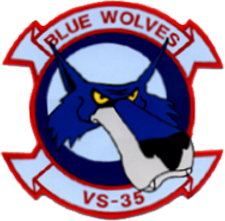
VS-35, Sea Control Squadron 35, known as the Blue Wolves was a carrier-based United States Navy squadron based out of Naval Air Station North Island in California. The squadron flew the Lockheed Lockheed S-3B Viking and their mission was mining, undersea and surface warfare, electronic reconnaissance and analysis, over the horizon targeting, and aerial refueling. The squadron was last attached to Carrier Air Wing Fourteen (CVW-14). VS-35 was deactivated in a ceremony at NAS North Island on 24 March 2005, and officially on 31 March 2005.

Helicopter Sea Combat Squadron 9 (HSC-9) "Tridents" is a United States Navy helicopter squadron based at Naval Air Station Norfolk, Norfolk, Virginia (USA). The squadron is equipped with the Sikorsky MH-60S Seahawk. Currently, HSC-9 is attached to Carrier Air Wing Eight. It was originally established as Helicopter Anti-Submarine Squadron 3 (HS-3) in 1952 and was redesignated on 1 June 2009.
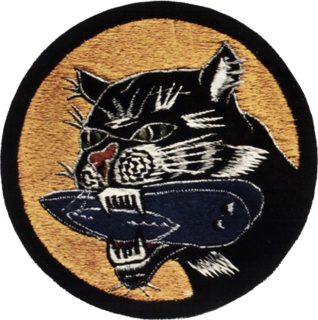
VS-23 was an Anti-Submarine Squadron of the U.S. Navy. It was disestablished on 27 September 1968.

VS-25 was an Anti-Submarine Squadron of the U.S. Navy. Originally established as Composite Squadron 25 on 1 April 1949, it was redesignated Anti-Submarine Squadron (VS-25) on 20 April 1950 and disestablished on 27 September 1968.

Sea Control Squadron 37 or VS-37 also known as the "Sawbucks" was an Anti Submarine Warfare squadron that was decommissioned in 1995 along with CVW-15. During its active history, it flew during the Korean and Vietnam Wars as well as operating the last S-2 Trackers inservice with the US Navy in 1975.
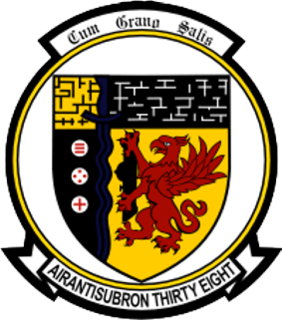
Sea Control Squadron 38 or VS-38, nicknamed the "Red Griffins" was a former United States Navy Anti-Submarine Warfare and later Sea-Control squadron between 1950 and 2004. During its service life, they took part in the Korean War, Vietnam War and the 1991 Gulf War and the 2003 Invasion of Iraq.

Sea Control Squadron 29 (VS-29) or the "Dragonfires" was a former Sea Control and anti-submarine warfare (ASW) squadron of the US Navy that existed between 1960 and 2004.






















